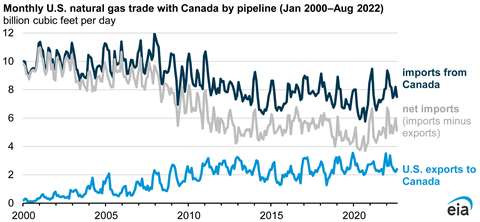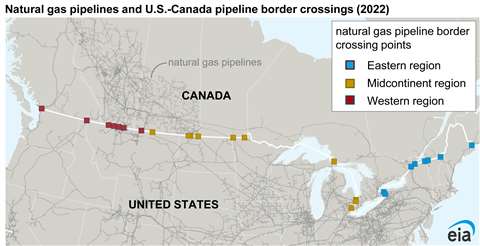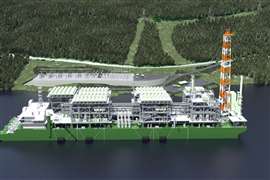Canadian gas provides buffer for U.S. markets
November 22, 2022

Natural gas imports from Canada into the U.S. have generally fallen over the last 15 years, but trade between the two countries remains an important element in balancing North American gas markets, a recent study has shown. The U.S. Energy Information Administration published a report that showed natural gas imports from Canada fluctuated wildly over the interim, but the supply from Canada has regularly ensured access to gas during periods of peak demand in the U.S.
Because of sufficient pipeline capacity and storage facilities, Canadian supplies can rapidly increase during times when demand surges in the U.S., a key stabilizing factor during periods of supply and demand, particularly during the cold winter months, the study shows.
In 2005, 17% of total U.S. supply of dry natural gas came from Canada. Since then, Canada’s share of imported dry natural gas supply to the United States has declined as U.S. gas production has grown.
As of the end of August, gross imports of dry natural gas from Canada accounted for, on average, 8% of U.S. supply, and U.S. natural gas production averaged 92%, or 97.0 billion cubic feet per day (Bcf/d), according to figures from the EIA.
During the same period, U.S. pipeline exports of natural gas to Canada have increased. In 2000, U.S. exports averaged 2% of all pipeline natural gas trade with Canada. In 2005, that share increased to 9%. Through August of this year, it averaged 24%, the EIA reported.
The flow of gas across the border between the two countries is not uniform. Natural gas imports from Canada to the western United States have provided a steady source of supply and have generally increased. So far this year, they have increased 4.1% compared with the same period a year ago. The border-crossing points at Sumas, Washington, and Eastport, Idaho, principally supply metropolitan areas in the Pacific Northwest and California, where several factors have challenged supply of gas this year.
Demand for gas to produce electric power has climbed in response to sustained high temperatures and an extreme heat wave. Drought across large portions of the western U.S. has lowered the amount of hydroelectric capacity and forced power producers to use more gas. Meanwhile, pipeline constraints from the Permian Basin have reduced natural gas flows to the western U.S.

In the eastern U.S., natural gas pipeline capacity has expanded and the region is typically a net export of gas to Canada for large portions of the year. Imports of gas from Canada, however, have supported seasonal fluctuations in consumption, particularly during the winter peak in the U.S., when cold temperatures lead to more demand for gas to heat homes.
Since 2012, imports into the eastern United States have generally peaked in January or February at approximately 2 Bcf/d and then again in July or August at approximately 1 Bcf/d, when high temperatures drive demand for air-conditioning. During the spring and fall, net flows of natural gas reverse, flowing into Canada to build inventories, the EIA reported.
During Winter Storm Uri in February 2021, U.S. natural gas production had record declines, and imports from Canada increased to 9.5 Bcf/d to meet U.S. demand, the highest monthly average since February 2011, according to statistics from the EIA.
MAGAZINE
NEWSLETTER

CONNECT WITH THE TEAM








